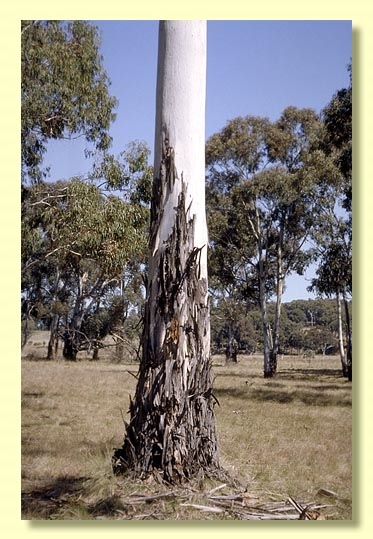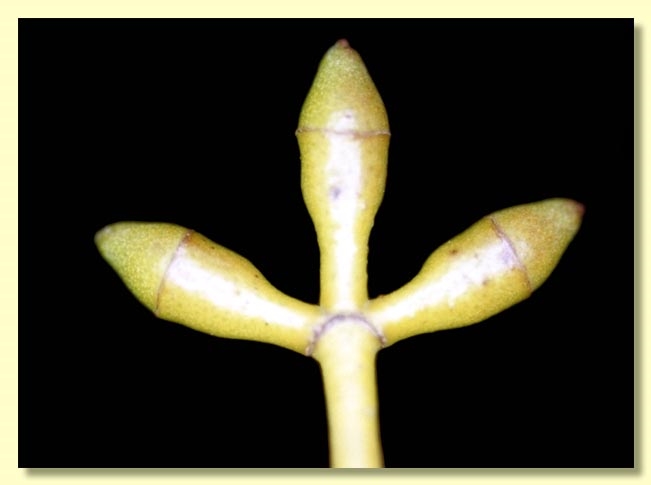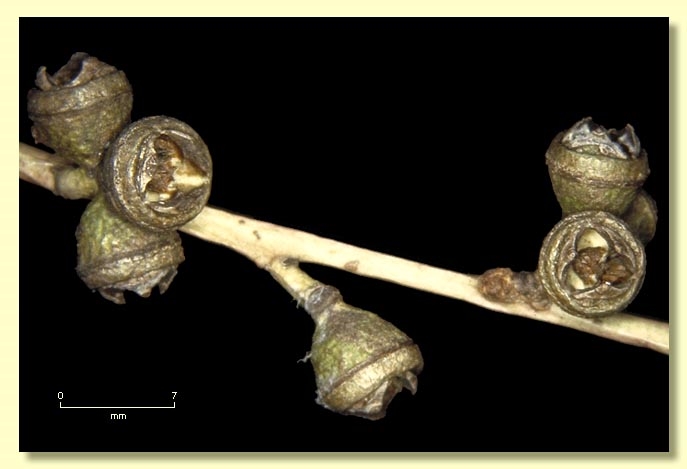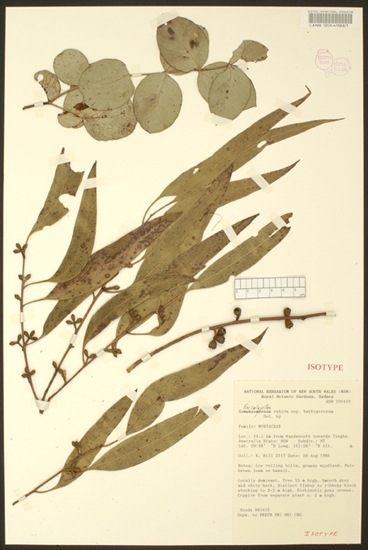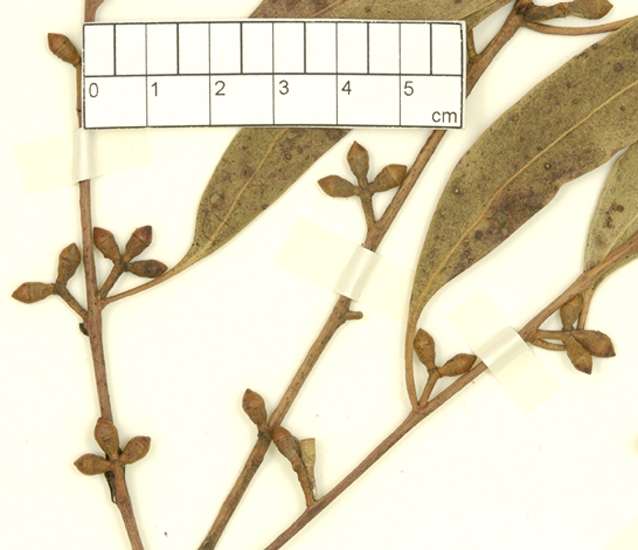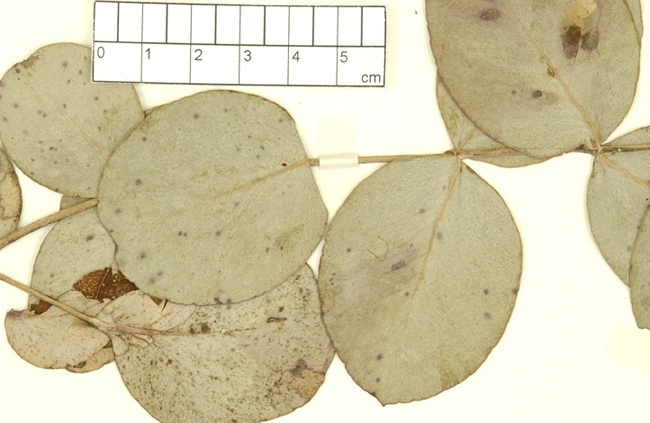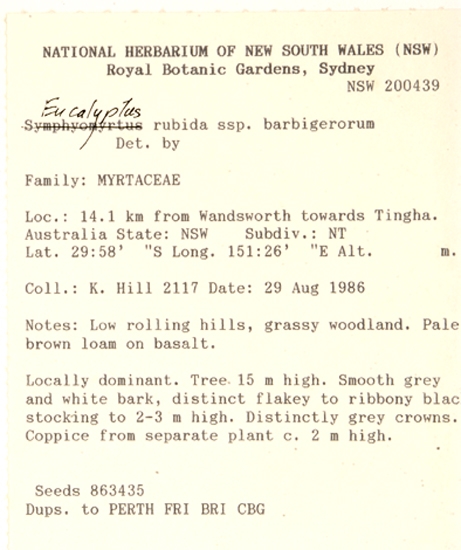Euclid - Online edition
Eucalyptus rubida subsp. barbigerorum
Classification
Eucalyptus | Symphyomyrtus | Maidenaria | Euryotae | Viminales | Circulares
Nomenclature
Eucalyptus rubida subsp. barbigerorum L.A.S.Johnson & K.D.Hill, Telopea 4: 240 (1991).
T: NSW, Northern Tablelands, 14.1 km from Wandsworth towards Tingha, 29 Aug. 1986, K.D.Hill 2117; holo: NSW; iso: BRI, CANB, PERTH.
T: NSW, Northern Tablelands, 14.1 km from Wandsworth towards Tingha, 29 Aug. 1986, K.D.Hill 2117; holo: NSW; iso: BRI, CANB, PERTH.
Description
Tree to 15 m tall. Forming a lignotuber.
Bark rough, persistent on base of trunk, thick, black to dark grey; smooth bark powdery, pale grey and white, sometimes with horizontal black scars; branchlets glaucous or non-glaucous.
Juvenile growth (coppice or field seedlings to 50 cm): stem rounded in cross-section, glaucous or non-glaucous; juvenile leaves opposite and sessile for many nodes, orbicular to ovate to cordate, 3–7 cm long, 2.2–5.5 cm wide, base stem-clasping to rounded, apex broadly pointed, glaucous.
Adult leaves alternate, petiole 0.8–3.3 cm long; blade lanceolate, 8–22 cm long, 1.3–3.3 cm wide, base tapering to petiole, concolorous, glossy or dull, green to blue-green or rarely glaucous, side-veins greater than 45° to midrib, densely to very densely reticulate, intramarginal vein parallel to and just within margin, oil glands usually obscure, sometimes a few island or intersectional.
Inflorescence axillary unbranched, peduncles 0.5–1 cm long, buds 3 per umbel, sessile or on pedicels to 0.4 cm long. Mature buds ovoid to fusiform, 0.7–0.9 cm long, 0.3–0.4 cm wide, green, or yellow or slightly glaucous, scar present, operculum conical, stamens irregularly flexed, anthers cuboid or cuneate, versatile, dorsifixed, dehiscing by longitudinal slits (non-confluent), style long, stigma blunt, locules 3 or 4, the placentae each with 4 vertical ovule rows. Flowers white.
Fruit sessile or on pedicels to 0.2 cm long, cup-shaped or hemispherical, 0.5–0.8 cm long, 0.5–0.8 cm wide, disc raised-convex, valves 3 or 4, exserted.
Seeds black or grey, 1.5–3 mm long, ovoid or flattened-ovoid, often pointed at one end, lacunose, dorsal surface smooth or shallowly pitted, hilum ventral.
Cultivated seedlings (measured at ca node 10): cotyledons bilobed; stems rounded in cross-section, glaucous; leaves opposite and sessile for many nodes, orbicular, 3–5 cm long, 3–5 cm wide, amplexicaul or base truncate to rounded, margin entire, apex rounded to pointed, dull, glaucous.
Bark rough, persistent on base of trunk, thick, black to dark grey; smooth bark powdery, pale grey and white, sometimes with horizontal black scars; branchlets glaucous or non-glaucous.
Juvenile growth (coppice or field seedlings to 50 cm): stem rounded in cross-section, glaucous or non-glaucous; juvenile leaves opposite and sessile for many nodes, orbicular to ovate to cordate, 3–7 cm long, 2.2–5.5 cm wide, base stem-clasping to rounded, apex broadly pointed, glaucous.
Adult leaves alternate, petiole 0.8–3.3 cm long; blade lanceolate, 8–22 cm long, 1.3–3.3 cm wide, base tapering to petiole, concolorous, glossy or dull, green to blue-green or rarely glaucous, side-veins greater than 45° to midrib, densely to very densely reticulate, intramarginal vein parallel to and just within margin, oil glands usually obscure, sometimes a few island or intersectional.
Inflorescence axillary unbranched, peduncles 0.5–1 cm long, buds 3 per umbel, sessile or on pedicels to 0.4 cm long. Mature buds ovoid to fusiform, 0.7–0.9 cm long, 0.3–0.4 cm wide, green, or yellow or slightly glaucous, scar present, operculum conical, stamens irregularly flexed, anthers cuboid or cuneate, versatile, dorsifixed, dehiscing by longitudinal slits (non-confluent), style long, stigma blunt, locules 3 or 4, the placentae each with 4 vertical ovule rows. Flowers white.
Fruit sessile or on pedicels to 0.2 cm long, cup-shaped or hemispherical, 0.5–0.8 cm long, 0.5–0.8 cm wide, disc raised-convex, valves 3 or 4, exserted.
Seeds black or grey, 1.5–3 mm long, ovoid or flattened-ovoid, often pointed at one end, lacunose, dorsal surface smooth or shallowly pitted, hilum ventral.
Cultivated seedlings (measured at ca node 10): cotyledons bilobed; stems rounded in cross-section, glaucous; leaves opposite and sessile for many nodes, orbicular, 3–5 cm long, 3–5 cm wide, amplexicaul or base truncate to rounded, margin entire, apex rounded to pointed, dull, glaucous.
Flowering Time
Flowering time not known.
Notes
Eucalyptus rubida is a species of small to medium-sized tree, often of poor form, widespread, usually on poor, shallow soils. It is one of the many three-budded species and is recognised by the strongly glaucous, sessile, opposite, round, juvenile leaves; the smooth white bark that sheds in large red-brown strips and which is often disfigured by horizontal black insect scars; and the crown of ultimately greyish green adult leaves, although these may ultimately become glossy. It differs from E. dalrympleana subsp. dalrympleana, which occurs on fertile soils and can be a tall tree of good form with light green juvenile leaves and bright green glossy adult leaves; and from E. viminalis subsp. viminalis, which favours wet valley situations and is notably a gum shedding bark in long ribbons, and which has lanceolate, green juvenile leaves. E. rubida was formerly believed to be in the Mt Lofty Range of South Australia; however, these tall trees have been shown to be E. dalrympleana subsp. dalrympleana. Another species closely related to E. rubida is E. canobolensis, which occurs on Mt Canobolas near Orange west of the Blue Mountains in New South Wales. It has a conspicuous grey crown and large, glaucous, orbicular juvenile leaves that persist until sapling stage. Another three-budded species from montane north-eastern Victoria and adjacent New South Wales, E. chapmaniana, differs from E. rubida in being predominantly rough-barked on the trunk and shedding in long ribbons on the branches.
There are two subspecies:
E. rubida subsp. rubida
This subspecies grows on hills, tablelands and mountain slopes of eastern Tasmania, in Victoria from Halls Gap east to Mt Delegate and usually on the northern side of the Divide, and throughout the Southern Tablelands of New South Wales. It has smooth bark. Trees of subsp. rubida in the Kiewa area of north-eastern Victoria occasionally have seven-flowered umbels and have been given the name E. rubida subsp. septemflora, which is not recognized in EUCLID as significantly different.
E. rubida subsp. barbigerorum
This species occurs to the north-west of Armidale on the Northern Tablelands of New South Wales. It is characterised by the rough black bark on the base of the tree.
Eucalyptus rubida belongs in Eucalyptus subgenus Symphyomyrtus section Maidenaria, a large group of species more or less restricted to south-eastern Australia, characterised by bilobed cotyledons, simple axillary inflorescences, buds with two opercula, stamens with versatile anthers and flattened seeds with a ventral hilum. Within this section, E. rubida belongs in series Viminales subseries Circulares, having buds in threes, fruit with an ascending disc and exserted valves, and glaucous, sessile, orbicular juvenile leaves opposite for many pairs.
Eucalyptus rubida subsp. barbigerorum is listed as "Vulnerable" under the Australian Government Environment Protection and Biodiversity Conservation Act 1999 (EPBC Act). Further information may be found at this web address:
http://www.environment.gov.au/cgi-bin/sprat/public/sprat.pl
There are two subspecies:
E. rubida subsp. rubida
This subspecies grows on hills, tablelands and mountain slopes of eastern Tasmania, in Victoria from Halls Gap east to Mt Delegate and usually on the northern side of the Divide, and throughout the Southern Tablelands of New South Wales. It has smooth bark. Trees of subsp. rubida in the Kiewa area of north-eastern Victoria occasionally have seven-flowered umbels and have been given the name E. rubida subsp. septemflora, which is not recognized in EUCLID as significantly different.
E. rubida subsp. barbigerorum
This species occurs to the north-west of Armidale on the Northern Tablelands of New South Wales. It is characterised by the rough black bark on the base of the tree.
Eucalyptus rubida belongs in Eucalyptus subgenus Symphyomyrtus section Maidenaria, a large group of species more or less restricted to south-eastern Australia, characterised by bilobed cotyledons, simple axillary inflorescences, buds with two opercula, stamens with versatile anthers and flattened seeds with a ventral hilum. Within this section, E. rubida belongs in series Viminales subseries Circulares, having buds in threes, fruit with an ascending disc and exserted valves, and glaucous, sessile, orbicular juvenile leaves opposite for many pairs.
Eucalyptus rubida subsp. barbigerorum is listed as "Vulnerable" under the Australian Government Environment Protection and Biodiversity Conservation Act 1999 (EPBC Act). Further information may be found at this web address:
http://www.environment.gov.au/cgi-bin/sprat/public/sprat.pl
Origin of Name
Eucalyptus rubida: Latin rubidus, red, referring to the seasonally red bark.
subsp. barbigerorum: Latin barbigerorum, of the beard-bearing ones, referring to the bearded pioneers of the district.
subsp. barbigerorum: Latin barbigerorum, of the beard-bearing ones, referring to the bearded pioneers of the district.
Copyright © CANBR 2020, all rights reserved.

Web edition hosted at https://apps.lucidcentral.org/euclid

